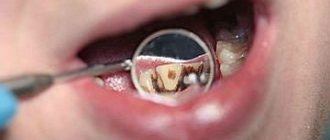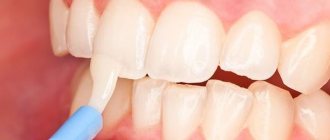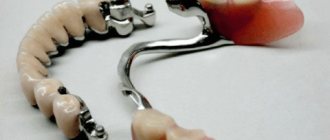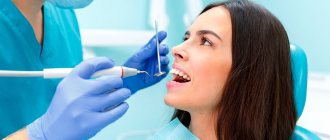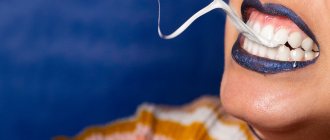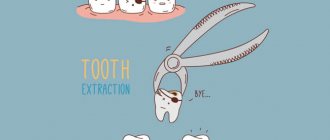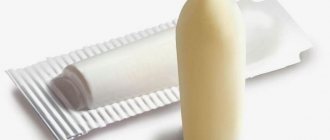Microorganisms that multiply in the oral cavity during caries and gum inflammation can spread throughout the body and lead to the following consequences:
- intrauterine infections,
- exacerbation of inflammatory diseases of the upper respiratory tract,
- indigestion,
- weakening of general immunity,
- increased risk of toxicosis and other complications of pregnancy,
not to mention bad breath, plaque, dryness and cracks in the oral mucosa.
Is it possible to treat teeth during pregnancy?
Most likely, the tooth will decay during this time (the bulk of the minerals go to build the fetal body), damage neighboring ones, and also become a source of infection for the newborn. Let's add a change in the properties of saliva, which, due to its increased viscosity, cannot fully wash and protect teeth, and weak mineralization.
The answer is clear: treat. To do this, you need to choose the right time, place, specialist and materials. The specialists at SM-Dentistry treat their patients very carefully and choose only safe treatment methods.
Gingivitis in pregnant women
Gingivitis in pregnancy is a common problem. Due to a lack of vitamin C, changes in hormonal levels and blood supply to the mucous membrane, the areas of gum between the teeth may become swollen and enlarged. They begin to bleed, and gingivitis develops due to the proliferation of bacteria. It can go away “on its own” after pregnancy, but with insufficient oral hygiene it can cause serious problems. Help to reduce risk:
- thorough home teeth cleaning;
- therapeutic and prophylactic paste recommended by a doctor, irrigators;
- anti-inflammatory therapy (approved).
What to pay attention to when treating teeth during pregnancy
Not every doctor will undertake dental treatment during pregnancy. However, an experienced dentist knows what determines the success and safety of treatment.
At what stage of pregnancy should treatment be carried out?
1st trimester (6-12 weeks). Dental treatment is contraindicated. All organs and systems of the baby are formed; the blood-placental barrier is not formed. Manipulation in the oral cavity can lead to the spread of infection and disruption of fetal development. The ban on treatment especially applies to x-ray examinations.
The exception is diseases in which the main symptom is acute pain. Then minimal intervention is performed to alleviate the condition.
The dentist must be informed about pregnancy, possible allergic reactions, and concomitant diseases.
2nd trimester (13-27 weeks). This is the perfect time to deal with your dental problems. During this period, it is good to carry out the following procedures:
- preventive measures, rehabilitation of potential foci of caries or periodontitis. For example, professional teeth cleaning;
- treatment of gingivitis (inflammation of the gums), which often develops due to hormonal changes and leads to bleeding gums.
- treatment of caries using safe modern materials that do not penetrate the placenta.
- tooth extraction. If the tooth is already destroyed and its removal is indicated, then the procedure is carried out as carefully as possible.
3rd trimester (from 28 weeks).
Again we switch to the most gentle mode.
Firstly, the risk of premature birth increases. Secondly, sitting in a dentist’s chair, even the most comfortable one, is no longer very comfortable. The load on the cardiovascular system also increases, which can cause fainting, a drop in blood pressure, or, conversely, a sharp increase in blood pressure.
There are other nuances:
- during pregnancy, teeth are restored using fillings with chemical and light hardening - the effect of photopolymer lamps is harmless;
- the main indications for rehabilitation are caries, inflammation of the pulp and gums, and other diseases that do not require unwanted and dangerous interventions;
- Treatment under anesthesia is acceptable - the main thing is to choose a drug approved during pregnancy;
- A mandatory procedure during pregnancy is preventive cleaning, which prevents the occurrence and development of diseases, is safe and helps prevent large-scale dental interventions.
The main thing that dentists say about dental treatment is that during pregnancy it is real and often necessary. You just need to report your condition and name the deadline. Then the specialist will select a safe and effective treatment method that is not dangerous for the baby and does not cause stress for the woman.
Dental prevention during pregnancy
- Treatment of carious teeth and periodontitis before pregnancy.
- Careful dental and oral care. In addition to mandatory brushing of teeth 2 times a day with high-quality toothpaste, it is recommended to use dental floss and rinse to prevent gum disease. You can use gels that restore enamel mineralization, reduce sensitivity and stop caries in the early stages.
- Nutrition should be complete; you can supplement it with vitamin and mineral complexes on the recommendation of the obstetrician-gynecologist who is managing the pregnancy and your trusted dentist.
- Preventive examinations in every trimester. Professional cleaning is usually carried out 2 times a year.
Finding your dentist is no less important than finding a gynecologist. When you trust a specialist, any manipulation will be easy and positive, which will definitely have a positive effect on the health of both mother and child.
Oral hygiene products for pregnant women
At first glance, oral hygiene during pregnancy is no different from any other period of our lives. But in reality this is not entirely true. Pregnant women's teeth are more fragile and weaker, since the baby takes a large amount of calcium and other useful minerals. To protect the enamel, it is necessary to use special pastes (with fluoride, calcium, medicinal herbs, etc.) without fragrances. You can purchase them in specialized online stores and pharmacies, after consulting with your doctor. The toothbrush should have medium-hard bristles or even soft bristles (always artificial bristles).
Every pregnant woman should have additional hygiene products, such as mouthwash You can also purchase dental floss and brushes to clean between your teeth. The irrigator removes up to 80% of plaque and allows you to maintain fresh breath and healthy teeth. To prevent caries, especially during pregnancy, such an attribute is simply necessary.
Carrying out diagnostics
To find out why breathing is difficult and to select effective methods for normalizing it, a thorough diagnosis is carried out. To clarify the causes of shortness of breath, the KRH Dental & Medica clinic performs:
- examination of the larynx using direct and indirect laryngoscopy;
- chest x-ray, fluoroscopy, bronchoscopy;
- spirometry, which allows you to assess the state of respiratory function;
- electrocardiography, daily Holter monitoring, determining the characteristics of the heart.
It is also provided for a test to determine the gas composition of the blood. To find out the reason why breathing is difficult, an MRI, tests for allergic reactions, and testing for tumor markers may be required.
Diagnostics: do's and don'ts
When treating the canal system, the bone surrounding the teeth and in other cases, it is necessary to carry out x-ray diagnostics. Pregnancy and classical “targeted” studies are incompatible. The growing fetus and its cells are susceptible to radiation exposure. However, even strict SanPin standards do not prohibit dental examinations according to indications, although they recommend postponing them to 16-25 weeks of pregnancy.
Today, advanced devices generate minimal doses of rays comparable in impact to watching TV or working at a computer for two hours. For greater safety during pregnancy, the abdomen and pelvic area are covered with a lead “apron” that blocks radiation, but even this is not necessary if the doctor uses a progressive technique.
Doctors consider digital radiovisiographs to be safe devices, whose radiation “load” is 90% less than in film devices. To carry out diagnostics using a compact device, you do not even need to leave the dental chair. There is an alternative - for example, DIAGNOcam devices, designed to analyze the coronal area of teeth. It is carried out without x-ray radiation, makes it possible to determine the degree of carious damage and carry out minimally invasive treatment.
Clinical researches
Many experts note the high effectiveness of Asepta products. Conducted at the Military Medical Academy named after. CM. Kirov research has shown that products for individual oral hygiene of the Asepta series allow, within 6 months after the completion of complex treatment, not only to improve oral hygiene and reduce inflammatory processes in the gums by 55.37%, but also to reduce number of relapses of localized periodontitis.
To increase the effectiveness of treatment of chronic localized periodontitis of traumatic etiology in young people, it is advisable to include series products in the complex of treatment and preventive measures.
Sources:
- Clinical studies of antisensitive toothpaste “Asepta Sensitive” (A.A. Leontyev, O.V. Kalinina, S.B. Ulitovsky) A.A. LEONTIEV, dentist O.V. KALININA, dentist S.B. ULITOVSKY, Doctor of Medical Sciences, Prof. Department of Therapeutic Dentistry, St. Petersburg State Medical University named after. acad. I.P. Pavlova
- The role of anti-inflammatory rinse in the treatment of periodontal diseases (L.Yu. Orekhova, A.A. Leontyev, S.B. Ulitovsky) L.Yu. OREKHOVA, Doctor of Medical Sciences, Prof., Head of Department; A.A. LEONTIEV, dentist; S.B. ULITOVSKY, Doctor of Medical Sciences, Prof. Department of Therapeutic Dentistry of St. Petersburg State Medical University named after. acad. I. P. Pavlova
- Report on determining/confirming the preventive properties of commercially produced personal oral hygiene products: Asepta toothpaste used in combination with Asepta mouthwash and Asepta gum balm Head. Department of PFS Doctor of Medical Sciences Professor S.B. Ulitovsky St. Petersburg State Medical University named after Academician I.P. Pavlova. Faculty of Dentistry. Department of Preventive Dentistry.
Indications
Indications for sanitation of the upper respiratory tract are the following symptoms:
- elevated temperature;
- difficulty breathing;
- decreased sense of smell;
- hearing loss and pain in the ears;
- sore, burning and sore throat.
If there are purulent plugs in the tonsils, the tonsils are washed. Indications for sanitation of the nasal cavity are accumulations of secretory or postoperative masses in the nose when it is impossible to remove them independently.
How does the violation manifest itself?
When there is a lack of air, a person is unable to breathe normally. Shortness of breath occurs, breathing movements become rapid. Against this background, general health deteriorates significantly. If there is constantly not enough air when breathing, the patient fears for his own life.
The feeling of lack of air can occur at rest and during physical activity, and have varying degrees of intensity. In any case, such a condition should not be ignored. Even if rare episodes occur, you should always consult a doctor.
Contraindications
Some sanitation methods are contraindicated for certain conditions. Thus, washing the tonsils is not indicated in acute infectious processes, active pulmonary tuberculosis, or severe dysfunction of the autonomic nervous system. Washing the paranasal sinuses using the “Cuckoo” method is contraindicated in case of epilepsy, frequent nosebleeds, and in childhood.
Sanitation of the sinuses and nasal passages is the same mandatory and necessary procedure as washing your face in the morning, taking a shower every day or brushing your teeth. After all, the nasal cavity performs a lot of important functions: from warming and purifying the inhaled air to participating in the formation of the timbre of the voice. Each paranasal sinus and each nasal passage is a place of accumulation of purulent masses and secreted mucous secretions, which must be removed to maintain the full functioning of the nasal cavity and sinuses. Infections await us everywhere: at work, at school, in kindergarten, in transport... And the path through which bacteria and viruses enter the body leads through the mucous membrane of the nasal cavity. It is the mucous membrane that acts as a kind of filter on which pathogens, foreign particles and allergens are retained. According to statistics, up to 80% of the pathogenic microflora contained in the inhaled air settles on the mucous membrane. It is not necessary to rinse every nasal passage or sinus every day. It is enough to sanitize the nasal cavity on a regular basis, not forgetting how important healthy sinuses and nasal mucosa are for the body.
Also, sanitation of the nasal passage and paranasal sinuses is carried out for such diseases and conditions as: acute and chronic sinusitis; acute and chronic rhinitis; various types of sinusitis; discharge of purulent masses from the nasal passages; difficulty in nasal breathing; pain in the nose area.
Sanitation of the external auditory canal (EAC) is a hygienic procedure that serves several purposes:
- Removing biological contaminants (earwax) from the ear canal.
- Treatment of the auditory canal with antimicrobial, anti-inflammatory, analgesic drugs.
Palatine tonsils are collections of lymphoid tissue that are located in the recess between the tongue and the soft palate.
They consist of multiple ducts, which in medical practice are called “lacunae”. It is in them that pathological content accumulates, which is a medium for the division of harmful microorganisms. Their active reproduction, in turn, leads to aggravation of chronic pathologies of the pharynx.
If a person is diagnosed with chronic tonsillitis, the doctor examines the entire mucous membrane of the patient’s oral cavity. The goal of therapy is the restoration of the structure of the tonsils and the mandatory stabilization of the immune system.
Treatment by trimester
The possibility and nature of treatment are greatly influenced by the timing of pregnancy. The state of the body changes from trimester to trimester, the fetus and its organs are constantly developing. The first 85 days are a bad time for all types of treatment, including dental ones. Local anti-inflammatory drugs, such as chlorhexidine, are allowed. The most undesirable dental interventions are:
- before the end of 1 week - this is one of the reasons why it is advisable to plan a pregnancy and know exactly its duration;
- from 3 to 7 weeks, during the “construction” of the child’s key organs;
- from 9 to 12 weeks - the placenta forms on them.
The period from 13 to 24 weeks is the safest for dental cleaning. The placenta already fully performs a protective function, all systems and organs of the fetus develop smoothly. If the patient has the opportunity to schedule visits to the doctor, it is better to schedule them from 16 to 18 weeks. In the third trimester, the body is weakened, the uterus is sensitive to drug effects, and due to excitability, stress and irritants sometimes provoke premature labor. If possible, planned therapy is postponed until after childbirth, and only urgently needed care is provided. The danger decreases from 26 to 28 weeks and from 36 to 38 weeks - dental sanitation can be completed, prevention is acceptable.
Pain relief at the dentist during pregnancy
Local anesthesia (an injection into the gum) is quite possible, however, during pregnancy there are a number of restrictions and features, so you must inform your doctor that you are expecting a baby.
Even if you still suspect that you might be pregnant, it is better to play it safe and tell your dentist about your suspicions - he will certainly select an effective and safe anesthetic for you and the child (for example, ultracaine or ubistezin). There are people who are terrified of the dental office and dream of solving their “dental” problems “by magic” - with the help of general anesthesia. I would like you to know: dental treatment under general anesthesia is generally a double-edged sword (no one can predict in advance how your body will react to anesthesia), and during pregnancy it is completely contraindicated.
